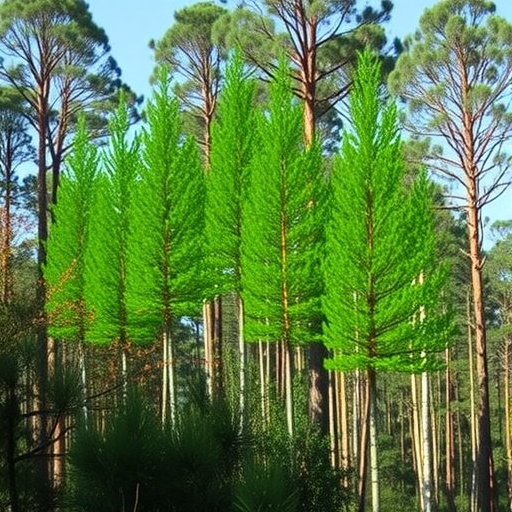In a groundbreaking examination of Australia’s carbon sequestration endeavors, researchers reveal that national-scale datasets are significantly underestimating the extent of vegetation recovery facilitated by human-induced native forest regeneration projects. The study, conducted by a team of scientists including Moore, O’Reilly-Nugent, and Clarke, sheds light on the crucial role these initiatives play in not only restoring biodiversity but also in combating climate change.
At the heart of the research is the notion that current methodologies for assessing vegetation recovery are overly simplistic. The scientists delve into the complexities of plant regrowth, particularly in the context of diverse ecosystems found across Australia. By employing high-resolution remote sensing technologies and rigorous field surveys, the team was able to paint a more accurate picture of the ecological recovery that follows restoration efforts.
One of the most striking findings of the study is the extent of vegetation rebound observed in project areas. Contrary to existing national-scale assessments which suggest modest increases in plant coverage, the researchers documented substantial improvements in both species diversity and biomass accumulation. The study delineates various projects across the Australian landscape, underscoring that regions often viewed as barren or minimally restored are, in reality, teeming with life.
The implications of these findings extend far beyond ecological assessments. Accurate data on vegetation recovery is critical for carbon accounting practices that underpin national and international climate policies. Given that healthy forests act as significant carbon sinks, the researchers argue that revamping how recovery is measured could lead to a reevaluation of Australia’s carbon crediting system—potentially increasing the available credits for carbon trading markets.
In exploring the loss and recovery of vegetation, the study emphasizes the necessity of considering local ecological contexts. Different species have distinct recovery patterns influenced by soil types, climate, and historical land use. The findings suggest that national datasets, which tend to generalize these factors, fail to capture the nuanced realities of plant recovery, particularly in varied and dynamic landscapes.
The authors also address the historical context of land degradation in Australia, where expansive agricultural practices and urban development have led to extensive deforestation. By highlighting the success stories of regeneration projects, the research offers a counter-narrative to the pervasive notion that restoration is a futile effort. The evidence gathered in this study showcases how targeted interventions can lead to significant ecological improvements.
As the research unfolds, the authors advocate for a more granular approach when assessing restoration projects. They argue that site-specific metrics should be employed, allowing for tailored management strategies that can enhance recovery efforts. This could lead to informed policy decisions that prioritize restoration in areas with the highest potential for ecological recovery.
Furthermore, the study underscores the urgency of fostering collaborative efforts among stakeholders—landowners, conservationists, and government agencies. By sharing detailed data on vegetation recovery, these parties can create a synergistic approach to conservation, ensuring that best practices are disseminated widely and effectively.
Despite the promising data on vegetation recovery presented in the study, the authors caution against complacency. They stress that while regeneration projects can significantly bolster ecological resilience, they cannot wholly compensate for the continuing loss of natural habitats. Therefore, it is crucial to complement restoration with proactive measures aimed at preventing further degradation.
In conclusion, this study marks an important step forward in our understanding of restoration ecology in Australia. By challenging the prevailing narratives around vegetation recovery and advocating for more precise measurements, the authors pave the way for a future where restoration projects can be more effectively valued and supported. This could have profound consequences for both biodiversity conservation and climate change mitigation efforts, redefining how Australia approaches its environmental responsibilities.
As the findings circulate in academic journals and the wider media, the hope is that they will inspire both policymakers and the public to recognize the potential embedded in restoration initiatives. By valuing and investing in ecological recovery, Australia can position itself as a leader in sustainable environmental practices, ultimately aiding the global fight against climate change.
In an era characterized by urgent climate challenges, the insights gleaned from this study are not merely academic; they demand action. With the right recognition and support, Australia’s restoration projects have the potential to contribute substantially to both local ecosystems and global carbon goals.
By integrating scientific knowledge with practical applications, researchers can play a vital role in shaping a sustainable future. The collaboration showcased in this study sets a precedent for how interdisciplinary efforts can yield transformative results in ecological restoration and beyond.
Subject of Research:
Article Title: National-scale datasets underestimate vegetation recovery in Australian human-induced native forest regeneration carbon sequestration projects.
Article References:
Moore, T., O’Reilly-Nugent, A., Clarke, K. et al. National-scale datasets underestimate vegetation recovery in Australian human-induced native forest regeneration carbon sequestration projects.
Commun Earth Environ 6, 802 (2025). https://doi.org/10.1038/s43247-025-02725-z
Image Credits: AI Generated
DOI: 10.1038/s43247-025-02725-z
Keywords: carbon sequestration, vegetation recovery, forest regeneration, Australia, biodiversity conservation, ecological resilience, climate change.




